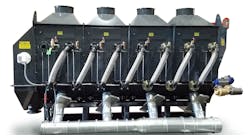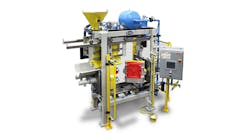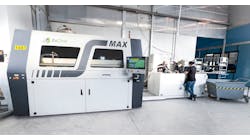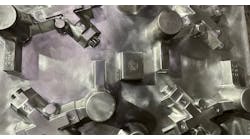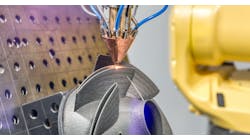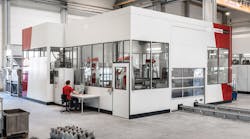Anyone working to establish a new molding operation today would have to start with a choice: focus on big issues, like mold size and productivity factors; or on small (but essential) details, like environmental impact. Working with sand to form molds (and cores) comes with numerous requirements, however. The operations have to be compliant with current and evolving regulatory standards, and they have to fulfill the prevailing commercial standards for process reliability and productivity, as well as finished product quality. But, they also have to keep options open for new market opportunities.
When Fairmount Santrol introduced its TechniSand TruCoat resin-coated sand this year, it was with the claim that the material has been engineered “to dramatically lower in-plant smoke, odor and emissions as well as deliver superior performance.” The developer added that the material would help foundries reduce hazardous air pollutants (HAPs) by 41%; drive free phenol levels down by 62%; and lower free formaldehyde by 35%.
In regard to hazardous air pollutants, odor, and smoke, the TechniSand developers indicated the product would lower smoke resulting from reduced emissions, and neutralize offensive odors with its patented Neozien® technology.
Foundries’ productivity factors would be improved by TechniSand TruCoat, Fairmount reported, because its resin-coating technology promotes superior casting quality, uniform curing, and fewer casting defects. Molds and cores produced with the materials reportedly support higher melt points, which improve metal flowability and casting finish. In addition, the sand’s better heat-transfer capabilities shorten cycle times and curing times.
The developer further claimed that the new sand product provides an opportunity for foundries to produce castings with reduced wall thicknesses, which cuts sand and resin usage, and thus minimizes waste.
In terms of productivity, the developer claimed that TechniSand TruCoat would reduce lamination and peel-back defects; increase “core strength” to reduce breakage, and lower Loss on Ignition (LOI) for fewer gas-related defects.
The always shifting needs of foundries and their customers, together with the evolving regulatory picture, means there is a constant search for new sand qualities and new binder formulations. Thus it was that the Hüttenus-Albertus (the global parent to HA International) recently highlighted the success of an andalusite sand in the production of complex ferrous castings for turbocharger housings.
Imerys Refractory Minerals mines, treats, and processes the andalusite in France, and in partnership HA has been offering Kerphalite KF as molding material for precision casting operations for about 20 years.
Kerphalite KF is a low-density product that can be used in pure form or blended with silica sand, as necessary. Thus, foundries can adjust the sand blend for process effectiveness and cost efficiency. It can be combined with all common binder systems, and is suitable for cold-box and shell molding processes, or the furan resin processes in ferrous casting.
Kerphalite KF also has also been used for 3D printing sand cores.
HA highlighted the value of such a flexible product in the production of complex geometries, castings with thin walls and precise dimensions, and high production volumes, such as turbocharger housings. These types of products are essential to foundries seeking to compete in automotive or industrial machinery production programs. The high-temperature load strength and sturdiness versus metal penetration make specialty sands like Kerphalite KF increasingly valuable to foundries vying for new business or expanded stakes in those high-visibility product categories.
Big Change in Progress
Flexibility and reliability are essential factors in molding processes, but there are other factors that could be emphasized in the start of a new molding operation: speed and precision, for example. Those are said to be among the primary advantages to foundries of 3D printing molds and cores, a process that has gained considerable market share in recent years. Another critical, but less obvious advantage is large-scale production. “The market for cast parts in the U.S. has always focused on size,” noted David Tait, managing director for voxeljet America.
Parent company voxeljet AG is among the major proponents of 3D sand printing, producing molds and cores for foundry customers by layering sand according to carefully defined programs, bonding each new layer to the preceding one until the digitally defined shape is realized.
In addition to producing molds, voxeljet designs and offers a series of large-format 3D printers. One of its models with a large work envelope (4,000×2,000×1,000 mm / L×W×H) is the centerpiece of a service center started up in Canton, MI, earlier this year. In fact, the VX4000 3D printer offers the largest continuous build volumes for sand molds.
“With the VX4000, we not only produce the largest sand molds in the world, but can also combine these with smaller mold components. The resulting flexibility provides for rapid delivery times and cost-efficient production,” Tait explained.
The past decade has seen significant progress by developers of additive manufacturing technology to make 3D sand printing amenable to foundry operations. The VX4000 reportedly is fast and easy to operate. Besides cost-effective production of very large individual molds, it can be used to produce small series parts, or combinations of each. The developer noted its finished molds feature stable side walls, meaning that the size of the build space can be adjusted as needed.
One design detail is particularly notable: The layer building process has been adapted for the VX4000, so that the building platform remains stable, and is not lowered during the printing process. Instead, the print head rises as each new layer is applied. The machine supports the weight of the building platform — which can be exchanged on a rail-driven mechanism — so that printing can continue uninterrupted for long sequences.
The implication of this is one that should be clear soon, if it is not already: additive manufacturing is a fully validated production route for molds and cores, able to address the dimensional and productivity (production volume, reliability, speed) concerns of today’s metalcasters. Its developers believe it is a viable approach to producing molds for high-value, and highly demanding, casting buyers in automotive and engineered parts industries, as well as in higher-volume commodity casting markets.
“We decided to place our largest printing system in the U.S. in order to service growing demand in the U.S. market directly on location, according to voxeljet AG chief operating officer Rudolf Franz. Our objective is to strengthen our most important growth market with a diversified portfolio of machines, materials, and processes.”




